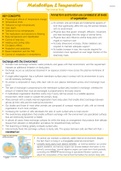Summary
Summary Metabolism and Temperature Notes
- Course
- Institution
- Book
This is a comprehensive summary and study material that includes lecture notes, textbook and other resource information pertaining to animal metabolism, transport and thermoregulation. It includes relevant and useful pictures and diagrams for a detailed understanding. All pages are loaded as A4. Th...
[Show more]





